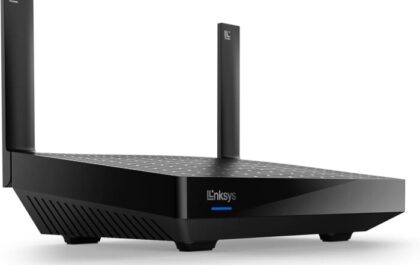Managing DD-WRT Access Restrictions
Access Restrictions can be configured to control what Internet content is available to the users on the LAN (Local Area Network). This may be beneficial for many reasons, including Office Control (limiting personal use during office hours) and Parental Control (restricting what websites can be accessed during and after school hours).
FAQ: What are the Benefits of using Access Controls with a Router?
Besides standard Office Control and Parental Control, there are many benefits to using a DD-WRT router with access restrictions capabilities. Here are some frequently asked questions concerning access controls and DD-WRT.
Can I have faster Internet with DD-WRT access controls?
While Internet speeds rely on many factors, primarily the modem connection to the ISP, you can still prioritize the speed of your connection by blocking sites and services that can cause a massive delay for your Internet speed with DD-WRT network performance management. Are your teenagers clogging up your Internet with late-night rounds of Halo on their Xbox One? Simply use DD-WRT access controls to block the MAC address of the Xbox, and your connection should be much faster.
Can I block Torrent use with a DD-WRT router?
Torrenting can really eat up active bandwidth, therefore, inhibiting speeds of your home network, as well as possibly get you in trouble with your ISP for illegally downloading copyrighted content. Using keywords like “torrent” or “p2p” within access restrictions can help block torrent sites on your network, which will take a load of these torrents off of your connection as well as make your network a safer place.
How can I set up a Parental Control access policy?
Setting up Parental Control access restrictions is the same as setting any other kind of access restrictions. Simply enter in keywords for gaming, adult content, or services you would not like your children to use, and the sites and services will be blocked. You can even set the router to only access select sites, so if you would like your children to be limited to specific educational sites, you can do so using the same settings.
How To Setup Access Policies in a DD-WRT Router
Here is a helpful DD-WRT Access Restrictions setup guide that will allow you to easily set up these restrictions on your router.
Logging into the DD-WRT Access Restrictions Setup
- Open your web browser and in the URL bar type 192.168.1.1
- Enter the username and password (root/admin)
- On the top menu bar, locate the Access Restrictions page
Managing Router/Internet Access Policies, Website
On the DD-WRT Access Restrictions Setup page, you will see the following fields presented from top-down:
- Access Policy
- Day
- Time
- Block Services
- Website Blocking by URL Address
- Website Blocking by Keyword
DD-WRT allows up to 10 individual Access Policies to be configured. This is useful in a situation where you have different users that have different levels of access or want to create a variety of timetables for Internet access for different users.
Note: There is a wide range of Access Policies that could be implemented. The policies implemented here are for example only, and it is recommended that only Advanced Users should attempt the configuration. If Internet connectivity is lost or some websites appear to be blocked, it may be a result of incorrect configuration, and all the Access Policies should be disabled as a first step.
Example: Office Deployment
In our example, the DD-WRT router is installed in an office to give office workers access to the Internet. The company IT policy does not allow the personal use of the Internet during business hours. However, as a courtesy before and after business hours, office workers can use their office PC for Internet banking and reading the news.
Policy (1) Work:
To do this there is a website restriction policy in place that blocks access to websites requiring log-in screens such as e-mail, blocking of file sharing websites and others that may distract works such as auction sites and personal e-mail. A timetable will be configured to restrict access from 9 am to 5 pm outside of these hours there is full access to the internet.
Policy (2) Weekend:
As the office is unattended on weekends, there is a second policy that denies all Internet access on Saturday and Sunday.
Access Restriction Policy & Setup on DD-WRT
First, we sill start with setting up Policy (1) Work.
1. Create Access Policy Main Details.
- Policy: Select the policy number to create or edit. For Work Policy select (1).
- Status: Enable or disable the policy. For Work Policy select Enable.
- Policy Name: Can be any value, in this case, it is called “Work.”
- PCs / Edit List of Clients: Edit the list of LAN PCs or network devices which will be subject to the access policy. This is covered in the next section.
- Deny /Filter: Deny will block all access during the specified timetable. Filter will apply the access policy in the later fields “Blocked Services”, “Website Blocking by URL Address” and “Website Blocking by Keyword”. For Work Policy select “Filter”.
- Days and Time: Select the days and time when the policy will be active. For the (1) Work policy example, configure the days Monday – Friday and 9:00 – 17:00 as the time when these policies will be active.
2. Edit List of Clients
Select Edit List of Clients in the access policy field. The above dialog will appear. Here there are several options to determine which LAN PCs and devices will be subject to the access restrictions.
- Enter MAC Address of the Clients: The client or connected devices can be specified by its MAC or Hardware address. This is useful for a system using WiFi or DHCP as the client may have a new IP address each time they connect to the network. For information on finding the MAC address, see xxxxx.
- Enter the IP Address of the Clients: if the PCs always use the same IP address (static IP) the addresses can be entered here.
- Enter the IP Range of the Clients: if there is an IP address pool used for the clients that will be subject to the access restrictions, enter it here.
- Back to the Work access policy, we will enter 192.168.1.100 ~ 192.168.1.200 in the IP range, which is the address range of the office worker PC.
- Then press Save and then Apply Settings.
Your DD-WRT router Work Policy is now complete.
3. Creating the Weekend Policy
Policy (2) is for the weekends. Here entry (2) is selected from the drop-down box, “Weekends” is used as the name and PCs is set to Deny.
The Day and Time fields are then completed, Sat & Sun for the weekend and 24 hours for the time.
Then press Save and then Apply Settings.
4. Creating Time Limits with DD-WRT
Back to the Access Policy field, press the Timetable button and a dialog appears showing the access policy in the hours that have been configured.
5. Select Services To Block
Return to the Access Policy field and select (1) Work. The Access Policy for services and websites will now be configured.
To do this scroll down to the Block Services field and check Catch All P2P Protocols. This blocks all file sharing applications such a torrents in this access policy.
For Advanced Users: Next a new service will be added to block login pages to websites such as email. To do this press Add/Edit Service.
All websites that have login pages use HTTPS and TCP port 443. To restrict access to these name the service HTTPS, select TCP for protocol and the Port range 443~443.
Press Add to add the service, then Save followed by Apply Settings.
Close the dialog and check the Blocked Services field.
The DD-WRT router is now configured to block all P2P Protocols and HTTPS. In the (1) Work Example access to websites requiring log in and P2P protocols such as file sharing are now blocked in this configuration.
6. Website Blocking by URL Address
This field is used to define individual websites that should be blocked in the access policy.
In (1) Work example websites that would be frequently accessed for personal use can be added, here there is eBay, Amazon, and YouTube.
The DD-WRT router can be configured to block any websites as per the network requirements or IT policy.
7. Website Blocking By Keyword
This field is used to define keywords that would appear in the webpage description field. The keywords can be configured according to network requirements or IP policy.
In (1) Work example websites that would be frequently accessed for personal use can be added, here there is eBay, Amazon, and Youtube.
The last step to press Save and Apply at the bottom of the page. This will save the Access Policy settings for the access policy select in the Access Policy field at the top of the page.
Note: that there are a wide range of Access Policies that could be implemented. The policies implemented here are for example only, and it is recommended that only Advanced Users should attempt the configuration. If internet connectivity is lost or some websites appear to be blocked, it may be a result of incorrect configuration, and all the Access Policies should be disabled as a first step.
What Are The Best DD-WRT Routers for Access Restrictions?
Managing access restrictions is one of the many advantages of using a DD-WRT router. If you are using a router flashed with DD-WRT, you open the door to using your router as a VPN connection, a repeater for a 3G/4G MiFi HotSpot, a central DNSMasq hub, and much more.
FlashRouters offers many routers with DD-WRT firmware installed and tested to work with access restrictions and policies. Router manufacturers leave these features off their firmware and save them for high-end business-class routers but our routers are tried and tested to work with access policies and more. Take a look at some of our most popular models below.
Linksys MR7350 WiFi 6 AX1800 DD-WRT FlashRouter

$279.99
- Upgraded with Latest DD-WRT Firmware
- WiFi 6 AX1800
Still now sure what you’re looking for? No worries, explore our best latest bestselling DD-WRT routers list.
















